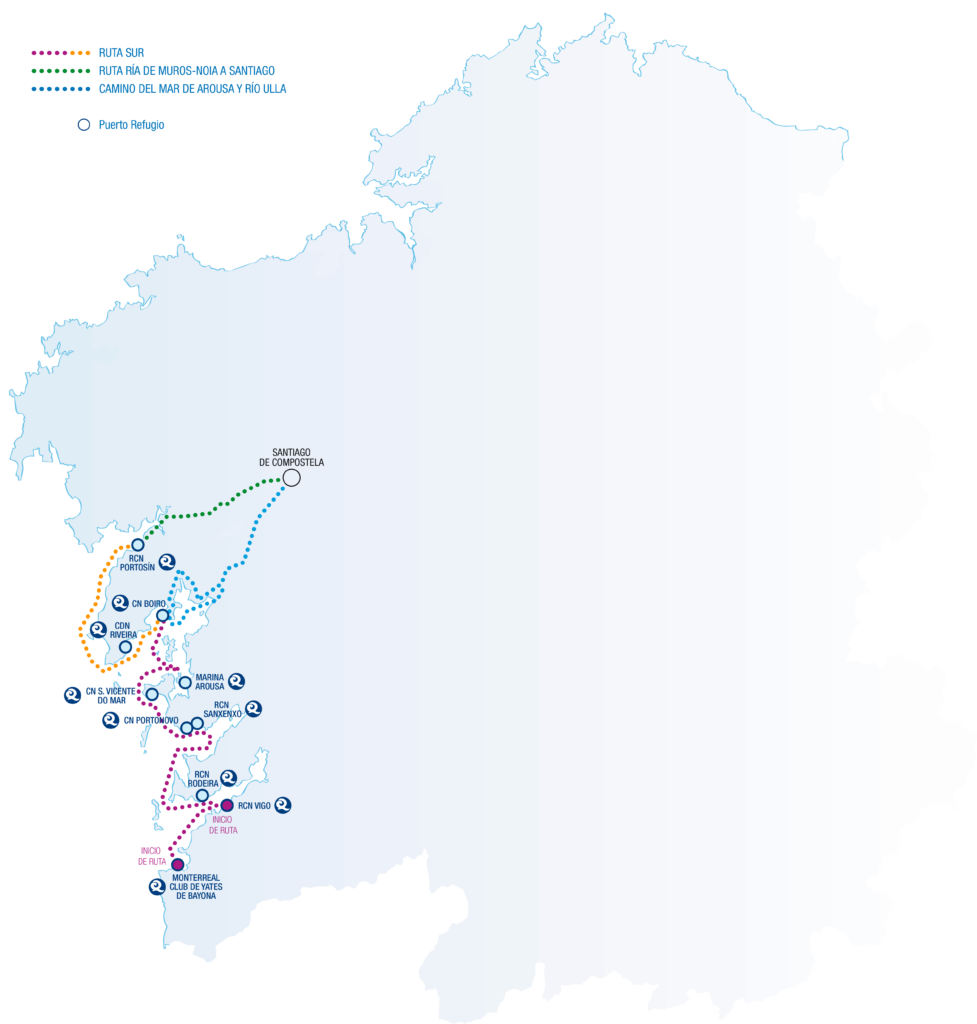Maritime pilgrimage
ORIGIN
ASNAUGA organized an unprecedented nautical pilgrimage, with the sponsorship of Turismo de Galicia with two fleets of 45 boats and 275 pilgrims
This project arose from the idea of commemorating, to a certain extent, the pilgrimage of St. Francis of Assisi and the Apostle’s Traslatio to Compostela by sea. It was first done in 2014
The northern route, more numerous, had its departure from Ribadeo where the ships from Europe (Ireland, England, France, etc.) concentrated, which together with the Spanish ships arrived at Viveiro, Sada, Ares, Camariñas, Portosín, Ribeira and Cabo of Cruz. The participants of both fleets went up the Ulla river in a catamaran to Ponte Cesures and from there to Santiago where it ended, after the religious acts in the Cathedral of Santiago.
The South route departed from Genoa (Italy) with stops in Toulon (France), Palma de Mallorca, Torrevieja, Cartagena, Roquetas, Marbella, Cádiz, Portimão, Sines, Cascais, Figueira Da Foz, Porto, Portonovo, Ribeira and Cabo de Cruz. Crews and boats were added to the expedition in the different ports of passage.

OBJECTIVES
Unite different towns and ports with the Xacobean tradition, through the development and education of all those people who want to know and get closer to the sea. Likewise, it promotes their participation in events with sailing boats.
Consolidate and officially recognize the pilgrimage route by sea
which existed in the Middle Ages, as one of the pilgrimage routes.
Unite different towns and ports with the Xacobean tradition
through the sea, get to know it and get closer to it
Promotes acceptance
Promotes acceptance of others regardless of social and cultural class
Develop a willingness to take controlled risks
Nautical education
Provides nautical education through sailing on sailboats.
Maritime culture and heritage
Disseminates maritime culture and heritage, and helps protect its environment.
Promote the “Ruta dos Faros
in which it is already integrated, through the Mar Galaica Project to which Asnauga belongs.
Marine tourism
Disseminate marine tourism, as well as its customs in the ports of call.
RUTAS E ITINERARIOS

The Xacobean Nautical Journey consists of two routes: the North and the South.
Sea crossing with two ports of entry in the Ría de Arousa and Ría de Muros Noia. Each Journey must be carried out within a maximum period of 6 months, a period in which the stamps of each port will be valid. It is mandatory to have the stamps of each port or Club of the Asnauga network, with the corresponding date.
The Journey must be carried out with a logical order of port calls, having reaching every one of them from the starting point.
The land leg begins at Milladoiro or Monte do Gozo, and the credentials must be stamped in the usual places.
The route called North begins with a meeting point in Ribadeo, and has a duration of four or five days.
- R.C.N. de Ribadeo
- C.N. Ría de Ares
- C.N. de Sada
- R.C.N. de La Coruña
- Technical stopover en el C.N. Camariñas
- R.C.N. de Portosín
From here, you can start the land route through Noia -or continue by sea to - C.N.D. Riveira
- C.N. de Boiro (in Cabo de Cruz)
On this route you could start at the earliest in Ares to be able to meet the 90 miles established.
The land route includes the last km of entry into Santiago de Compostela (Milladoiro).
This route is done in 3 or 4 stages.
- el R.C.N. de Vigo
- R.C.N de Rodeira (en Cangas)
- C.N. de Portonovo
- R.C.N de Sanxenxo
- C.N. de San Vicente do Mar (en O Grove)
- C.N.D. Riveira
- Technical stopover in Marina Arousa
- C.N. de Boiro (en Cabo de Cruz)
From here, you can start the land route or continue by sea to - R.C.N de Portosín
In this Route it is mandatory to touch all the Club facilities in order to comply with the provisions.
If you want to continue to the R.C.N. of Portosin, it will be done as follows: Departure from the R.C.N. of Vigo, R.C.N. of Rodeira (in Cangas), C.N. of Portonovo, R.C.N. of Sanxenxo, C.N. of San Vicente do Mar (in O Grove), CND de Riveira, technical stopover at Marina Arousa, and R.C.N. de Portosín.
The land route includes the last km of entry into Santiago de Compostela (Milladoiro).
WHERE TO GET INFORMATION AND
CREDENTIALS
Information is available in all clubs and facilities in the Asnauga network.
NORTH ROUTE
Real Club Náutico de Ribadeo
982120428
[email protected]
Asnauga
[email protected]
Club Náutico Ría de Ares
[email protected]
Sailway
[email protected]
SOUTH ROUTE
Real Club Náutico de Vigo
986 447 441
[email protected]
Asnauga
[email protected]
Liceo Marítimo de Bouzaa
986 232 442
[email protected]
Sailway
[email protected]

The Compostela is the official certification of having made the pilgrimage to Santiago de Compostela. It is granted by the Cathedral of Santiago.
It must have the stamps of each of the Asnauga network facilities, the individual and mandatory stamping.
The diploma of “La Compostela” must be collected personally by each nautical pilgrim at the pilgrim’s office, once the requirements have been met. Pilgrims must deliver the pilgrim’s credential provided by the Cathedral.
PILGRIMS RECEPTION OFFICE
Rúa Carretas 33, Santiago de Compostela
981 568 846


